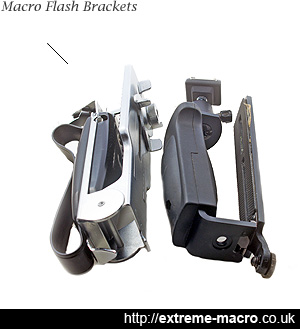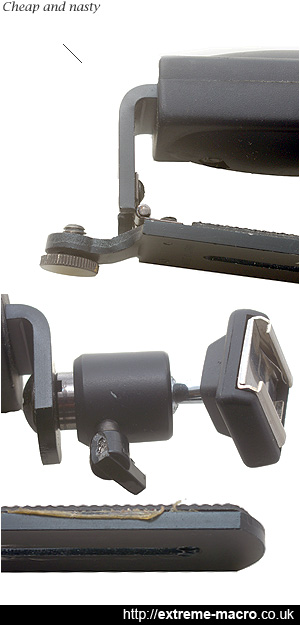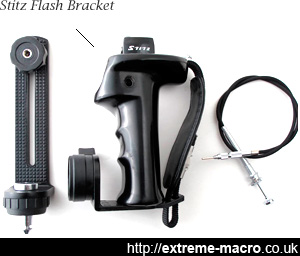Flash Brackets
by Johan J Ingles-Le Nobel
Last updated August 31, 2017
Part of the standard extreme macro toolkit, a macro flash bracket (also known as macro flash arms) is a handy accessory to have as it lets you hold your camera and a bit of an off camera flash at the same time, all in one package.

Flash brackets. The decent solid old one is on the left, the rubbishy modern cheapo is on the right.
Unfortunately I've had bad experiences with some modern macro flash bracket purchases, so the one I now use is an old archaic one that weighs a ton, but it's made out of rock solid metal and the flash doesn't slip or budge an inch, ideal.
Most macro flash bracket brackets are quite simple: they screw in on the tripod screw under the camera and have an arm to the left with a flash mount that you can mount your flash on. You use a *TTL cord to connect the flash to the camera or you use a PC-Sync cord. PC-sync limits the flash functionality you can use to manual, you can't use *TTL on PC-sync.
Why a Flash Bracket?
There are several reasons for actually using a macro flash bracket: to gain off-centre light (usually a bit nicer than a flash mounted on the camera), and to protect the hotshoe of the camera itself.

The inadequacies of a rubbish eBay macro flash arm. The hinge is flimsy so the flash wobbles, the tightening handle breaks quickly because you have to tighten it so much to get stability, and the glue seeps out under the rubber. Rubbish.
There are many instances where a camera's hotshoe has been damaged because a big flash sitting in it is either too heavy, or has been dropped. Also, a long lens casts a shadow of the flash is mounted on top and you're shooting close, and having the flash off to the side some distance on a bracket stops this problem.
Flash Brackets & Diffusion
Macro flash brackets also make it both easier to use diffusion and harder. Easier, because the diffusion can be placed close to what you intend to shoot rather than it being big and bulky, overhanging from a flash mounted on top. See for example a horizontally mounted flash using that idea. But it's also awkward: a flash on a bracket to the side with a big diffuser on it doesn't make for a compact package that you can manoeuvre into all angles and positions to get the shot you want. So there's an upside and downside.
I personally stopped using my flash bracket too much once I worked out a horizontal configuration for my flash, as the horizontal flash made my outdoor config nice and compact, and it meant I could get into all manner of spaces and places that I couldn't using a flash bracket.
Flash Brackets Connections
Something to bear in mind is that you will also need to still connect the camera to the flash. I used to use PC-Sync cords for this but unfortunately PC-Sync is a limited communication protocol that doesn't permit rear sync mode, so I now use a PTTL connection cord.
Flash Bracket Recommendations
Stay away from cheap eBay flash brackets: the one I purchased had a very thin almost bendy metal base and the vertical arm wobbled. The things to measure a decent flash arm on are how solid it is in terms of securing the flash at the angle and position you want it. The big old bulky made of steel flash arms maybe heavy, but in terms of performance, with a flash arm you Stay away from cheap eBay flash brackets want something that's as rigid as possible rather than pretty looking but wobbly flash arms. Old ones from many years ago are simply better made. The cheap circular ones and the ones made with spherical balls really don't work well unless you're only putting the smallest and lightest of flashes on there. You also have to be careful with brackets that mount the flash overhead leaning down because of the excessive pressure this puts on the flash hotshoe, which is often the first part to break with flash units.
That said, it is also desirable to keep a flash above a lens when the camera is in either landscape or portrait orientation, and because most older flash brackets cannot rotate the flash round the lens, they are thought of as having limited utility nowadays. Having said that it works for me, what can I say!
Stitz Brackets

Stitz flash bracket, solid as a rock and you can angle it too.
A nice solid old bracket to keep an eye out for is a Stitz Bracket. I was lucky enough to find one on Ebay for £5, but they're normally sold for anything up to £50. The Stitz bracket distinguishes itself with a rock-solid build, a moulded handgrip and handguard, a hotshoe with pc-sync connection and a rotating hinge which joins body bracket to handle. This hinge is really handy because it means you can angle your flash forward or down, and it locks and unlocks with a flip of a lever. It maybe 40 years old and made of hip 70s moulded plastic, but it's better than 90% of the flash brackets produced today. Sunpak, Vivitar, Leica, Hasselblad and Mamiya all made similar brackets. With flash brackets, the truth is that vintage is simply more reliable. And if you're left handed then Hasselblad even did a left handed flash bracket.
Related Articles


